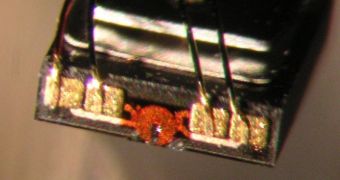Magnetic recording are data storage applications that use different patterns of magnetization on a magnetically coated surface to store data and represent non-volatile memory. One or more read and write heads are used to access the information.
Now, a group of scientists at the Radboud University Nijmegen in the Netherlands demonstrated the first magnetic recording technique that makes the recording head obsolete. Daniel Stanciu, lead researcher, said that flipping the magnetic orientation of a tiny domain is made with the magnetic fields present in a short burst of circularly polarized light.
Writing heads work by creating a strong magnetic field in the gap of a C-shaped piece of highly magnetizable material called ferrite, wrapped in a fine wire coil. This magnetizes the recording surface adjacent to the gap to create patterns that can be interpreted as data.
The new technique uses light instead of a magnet to do the same thing, because magnets are relatively slow and because the magnetic field created in the light pulse is naturally stronger, up to 5 Tesla. For comparison, the Earth's magnetic field at the equator is 31 microtesla, one millionth of a Tesla.
The light pulses are incident at a 90 degrees angle on the storage medium and the helicity of the pulse - the extent to which a magnetic field "wraps around itself" - determines whether the orientation induced in the domain will be up or down, meaning a 1 or a 0 in digital terms.
It's this orientation of the domain that writes a bit, being generated partly through the light's magnetism and partly through the localized heating by the pulse that actually enhances the magnetic susceptibility of the domain. Reversing a bit is done by using light of opposite polarization.
The pulse itself is perfectly focused, so that it only addresses one domain at a time, making possible the recording of individual bits. The actual recording speed, adjusted by the duration of the laser pulse, is of 40 femtoseconds (a femtosecond is a quadrillionth of a second).
A few years ago, some scientists predicted that this recording speed in an optical medium could not be reduced to less than a trillionth of second, but now the new technique clearly dismisses that assumption.

 14 DAY TRIAL //
14 DAY TRIAL //